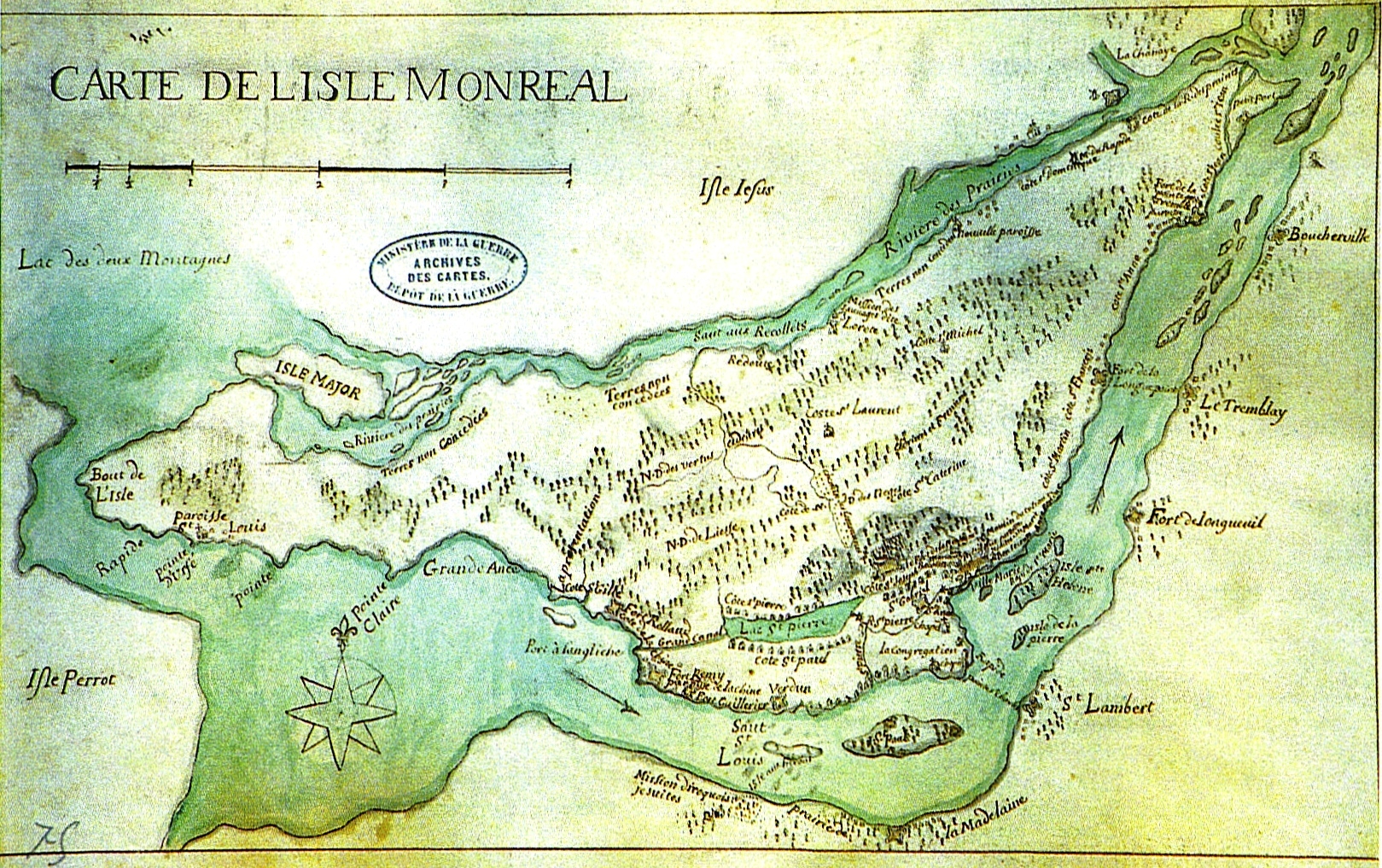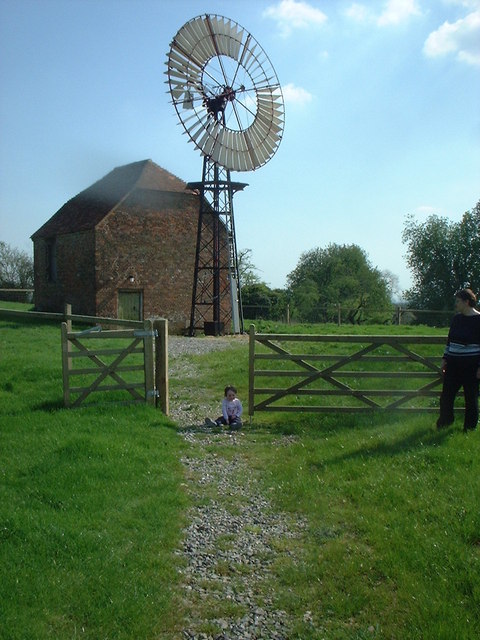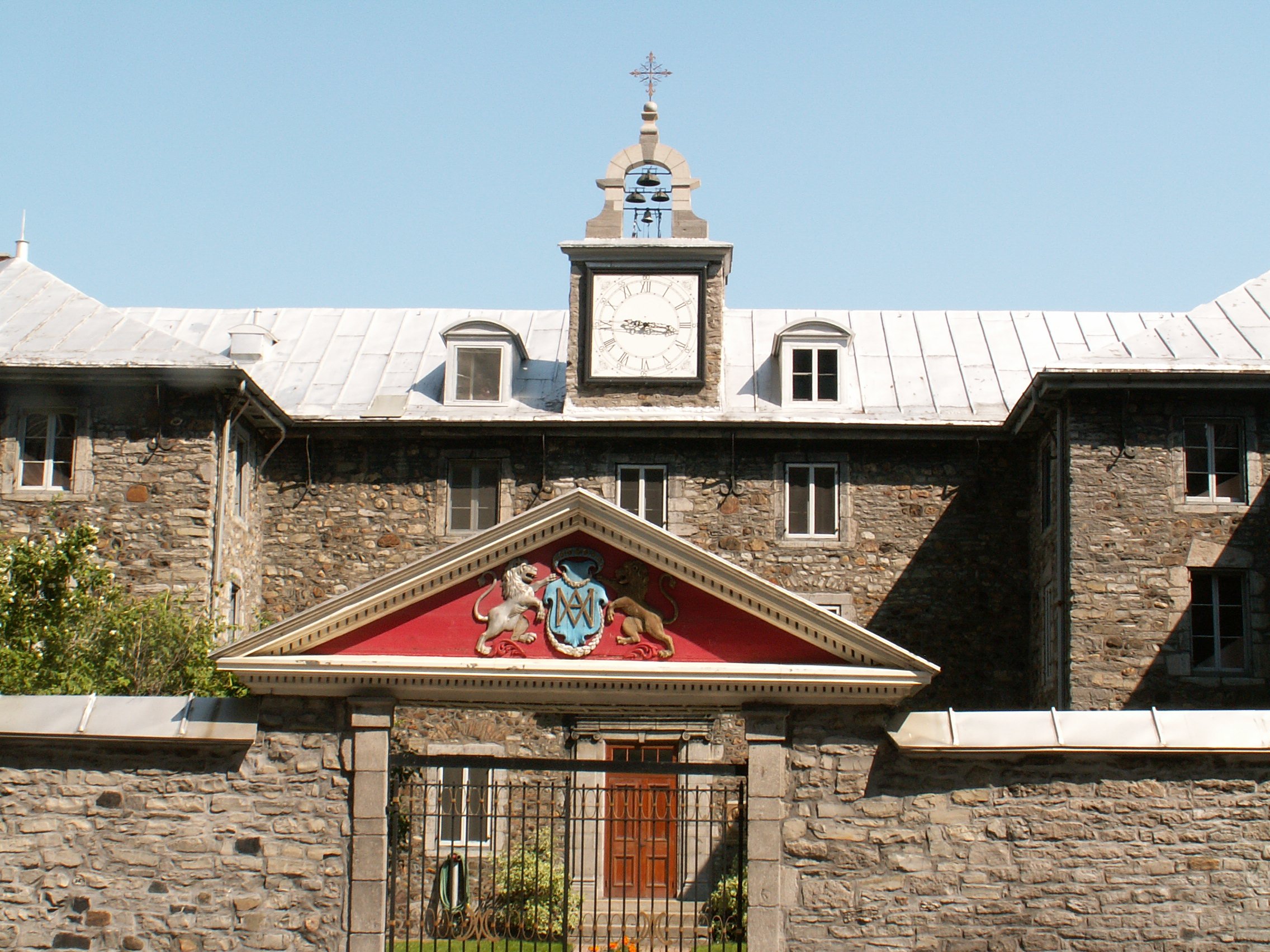|
Pointe-Claire Windmill
The Pointe-Claire Windmill (French: Moulin à vent de Pointe-Claire) is a windmill in Pointe-Claire, Quebec, Canada. It is the oldest windmill on the island of Montreal and one of 18 remaining windmills in Quebec. Like most mills in New France it was built to a French design, a cylindrical stone tower with a movable roof which could be turned by a tail pole to face the sails to the wind. The mill had two doors, to provide an exit regardless of which ways the sails faced. The walls are four French feet (1m32) thick at the base. The interior is 12 French feet in diameter by 24 high. The mill originally contained elevated platforms beneath gun slits for defence. The surrounding shoreline was fenced with pointed wooden stakes. However, the site was never attacked. Chronology * 1709: construction began in spring for the Society of Saint-Sulpice by stone mason Jean Mars, and Léonard Paillé dit Paillard and his son Charles for other parts of the construction. * 1710: construction ... [...More Info...] [...Related Items...] OR: [Wikipedia] [Google] [Baidu] |
Pointe-Claire
Pointe-Claire (, ) is a Quebec local municipality within the Urban agglomeration of Montreal on the Island of Montreal in Canada. It is entirely developed, and land use includes residential, light manufacturing, and retail. As of the 2021 census the population was 33,488. Toponymy The toponym refers to the peninsula, or point, where the windmill, convent, and the Saint-Joachim de Pointe-Claire Church are sited. The point extends into Lac Saint-Louis and has a clear view of its surroundings. History Pointe-Claire was first described by Nicolas Perrot in his account of 1669, and the name Pointe-Claire appeared on a map as early as 1686. Although Samuel de Champlain canoed through the area in 1613, he reported no village or dwelling visible. The urbanization of the territory of Pointe-Claire began in the 1600s, when the Sulpicians were lords of the island of Montreal. Land on the island of Montreal was granted to the Sulpicians for development as early as 1663. They began ... [...More Info...] [...Related Items...] OR: [Wikipedia] [Google] [Baidu] |
Windmill
A windmill is a structure that converts wind power into rotational energy using vanes called windmill sail, sails or blades, specifically to mill (grinding), mill grain (gristmills), but the term is also extended to windpumps, wind turbines, and other applications, in some parts of the English speaking world. The term wind engine is sometimes used to describe such devices. Windmills were used throughout the High Middle Ages, high medieval and early modern periods; the horizontal or panemone windmill first appeared in Persia during the 9th century, and the vertical windmill first appeared in northwestern Europe in the 12th century. Regarded as an icon of Culture of the Netherlands, Dutch culture, there are approximately 1,000 windmills in the Netherlands today. Forerunners Wind-powered machines may have been known earlier, but there is no clear evidence of windmills before the 9th century. Hero of Alexandria (Heron) in first-century Roman Egypt described what appears to be a ... [...More Info...] [...Related Items...] OR: [Wikipedia] [Google] [Baidu] |
Island Of Montreal
The Island of Montreal (french: Île de Montréal) is a large island in southwestern Quebec, Canada, that is the site of a number of municipalities including most of the city of Montreal and is the most populous island in Canada. It is the main island of the Hochelaga Archipelago at the confluence of the Saint Lawrence and Ottawa rivers. Name The first French name for the island was ''l'ille de Vilmenon'', noted by Samuel de Champlain in a 1616 map, and derived from the sieur de Vilmenon, a patron of the founders of Quebec at the court of Louis XIII. However, by 1632 Champlain referred to the ''Isle de Mont-real'' in another map. The island derived its name from Mount Royal ( French ''Mont Royal'', then pronounced ), and gradually spread its name to the town, which had originally been called Ville-Marie. In Kanien’kéha, the island is called Tiohtià:ke tsi ionhwéntsare ('broken in two', referring to the Lachine Rapids to the island's southwest) or Otsirà:ke (meaning ' ... [...More Info...] [...Related Items...] OR: [Wikipedia] [Google] [Baidu] |
List Of Windmills In Quebec ...
Windmills in Quebec Notes Mills still standing shown in bold. Known building dates are in bold text. Non-bold text denotes first known date. References Further reading * {{DEFAULTSORT:Windmills in Quebec Quebec Quebec Windmills A windmill is a structure that converts wind power into rotational energy using vanes called sails or blades, specifically to mill grain (gristmills), but the term is also extended to windpumps, wind turbines, and other applications, in some par ... [...More Info...] [...Related Items...] OR: [Wikipedia] [Google] [Baidu] |
New France
New France (french: Nouvelle-France) was the area colonized by France in North America, beginning with the exploration of the Gulf of Saint Lawrence by Jacques Cartier in 1534 and ending with the cession of New France to Great Britain and Spain in 1763 under the Treaty of Paris. The vast territory of ''New France'' consisted of five colonies at its peak in 1712, each with its own administration: Canada, the most developed colony, was divided into the districts of Québec, Trois-Rivières, and Montréal; Hudson Bay; Acadie in the northeast; Plaisance on the island of Newfoundland; and Louisiane. It extended from Newfoundland to the Canadian Prairies and from Hudson Bay to the Gulf of Mexico, including all the Great Lakes of North America. In the 16th century, the lands were used primarily to draw from the wealth of natural resources such as furs through trade with the various indigenous peoples. In the seventeenth century, successful settlements began in Acadia and in Quebe ... [...More Info...] [...Related Items...] OR: [Wikipedia] [Google] [Baidu] |
Windmill Sail
Windmills are powered by their sails. Sails are found in different designs, from primitive common sails to the advanced patent sails. Jib sails The jib sail is found in Mediterranean countries and consists of a simple triangle of cloth wound round a spar. The mill must be stopped in order to adjust the reefing of the sail. Though rare in the UK, at least two windmills are known to have had jib sails (St Mary's, Isle of Scilly and Cann Mills, Melbury Abbas). Image:Windmill Antimahia Kos.jpg, Jib sails Image:Sobreiro.jpg, More fully spread Image:Spanish Mill, St Mary's.jpg, St Mary's, Isles of Scilly File:Cann Mill, Melbury Abbas.jpg, Cann Mills, Melbury Abbas Common sails The common sail is the simplest form of sail. In medieval mills, the sailcloth was wound in and out of a ladder-type arrangement of sails. Medieval sails could be constructed with or without outer sailbars. Post-medieval mill sails have a lattice framework over which the sailcloth is spread. There are variou ... [...More Info...] [...Related Items...] OR: [Wikipedia] [Google] [Baidu] |
French Foot (unit)
200px, Woodcut dated 1800 illustrating the new decimal units which became the legal norm across all France on 4 November 1800 The traditional French units of measurement prior to metrification were established under Charlemagne during the Carolingian Renaissance. Based on contemporary Byzantine and ancient Roman measures, the system established some consistency across his empire but, after his death, the empire fragmented and subsequent rulers and variously localities introduced their own variants. Some of Charlemagne's units, such as the king's foot (french: pied du Roi) remained virtually unchanged for about a thousand years, while others important to commercesuch as the French ell () used for cloth and the French pound () used for amountsvaried dramatically from locality to locality. By the 18th century, the number of units of measure had grown to the extent that it was almost impossible to keep track of them and one of the major legacies of the French Revolution was the dra ... [...More Info...] [...Related Items...] OR: [Wikipedia] [Google] [Baidu] |
Society Of Saint-Sulpice
The Society of Priests of Saint-Sulpice (french: Compagnie des Prêtres de Saint-Sulpice), abbreviated PSS also known as the Sulpicians is a society of apostolic life of Pontifical Right for men, named after the Church of Saint-Sulpice, Paris, where it was founded. The members of the Society add the nominal letters PSS after their names to indicate membership in the Congregation. Typically, priests become members of the Society of the Priests of St. Sulpice only after ordination and some years of pastoral work. The purpose of the society is mainly the education of priests and to some extent parish work. As their main role is the education of those preparing to become priests, Sulpicians place great emphasis on the academic and spiritual formation of their own members, who commit themselves to undergoing lifelong development in these areas. The Society is divided into three provinces, operating in various countries: the Province of France, Canada, and the United States. In Franc ... [...More Info...] [...Related Items...] OR: [Wikipedia] [Google] [Baidu] |
Stone Mason
In geology, rock (or stone) is any naturally occurring solid mass or aggregate of minerals or mineraloid matter. It is categorized by the minerals included, its chemical composition, and the way in which it is formed. Rocks form the Earth's outer solid layer, the crust, and most of its interior, except for the liquid outer core and pockets of magma in the asthenosphere. The study of rocks involves multiple subdisciplines of geology, including petrology and mineralogy. It may be limited to rocks found on Earth, or it may include planetary geology that studies the rocks of other celestial objects. Rocks are usually grouped into three main groups: igneous rocks, sedimentary rocks and metamorphic rocks. Igneous rocks are formed when magma cools in the Earth's crust, or lava cools on the ground surface or the seabed. Sedimentary rocks are formed by diagenesis and lithification of sediments, which in turn are formed by the weathering, transport, and deposition of existing rocks. M ... [...More Info...] [...Related Items...] OR: [Wikipedia] [Google] [Baidu] |
Rigaud, Quebec
Rigaud () is a city in southwestern Quebec, Canada, in the Vaudreuil-Soulanges Regional County Municipality in Vallée-du-Haut-Saint-Laurent region. It is located at the junction of the Ottawa River and the Rigaud River, about west of downtown Montreal and east of Ottawa. The population as of the Canada 2021 Census was 7,854. History Rigaud is located on the traditional territory of the Algonquin people, Algonquins, who fled the region before the arrival of the French, due to violent attacks by the Iroquois people, Iroquois. Étienne Brûlé was the first European colonization of the Americas, European to travel on the Ottawa River,in 1615 in Quebec, 1615. The :fr:Seigneurie de Rigaud, Seigneury of Rigaud was granted in 1732 to the brothers Pierre de Rigaud, marquis de Vaudreuil-Cavagnial, Pierre and François-Pierre Rigaud de Vaudreuil, François-Pierre de Rigaud de Vaudreuil, governors in New France, and was sold in 1763 to Michel Chartier de Lotbinière, Marquis de Lotbini� ... [...More Info...] [...Related Items...] OR: [Wikipedia] [Google] [Baidu] |
Congregation Of Notre Dame Of Montreal
The Congrégation de Notre Dame (CND) is a religious community for women founded in 1658 in Ville Marie (Montreal), in the colony of New France, now part of Canada. It was established by Marguerite Bourgeoys, who was recruited in France to create a religious community in Ville Marie. She developed a congregation for women that was not cloistered; the sisters were allowed to live and work outside the convent. The Congregation held an important role in the development of New France, as it supported women and girls in the colony and offered roles for them outside the home. It also founded a boarding school for girls' education, and watched over the ''filles du roi'', women immigrants whose passage to the colony was paid by the Crown, which wished to encourage marriages and the development of families in the colony. Some ''filles de roi'' and sisters served as missionaries to the First Nations peoples. The community's motherhouse has been based in Montreal for more than 350 years. Ma ... [...More Info...] [...Related Items...] OR: [Wikipedia] [Google] [Baidu] |
Buildings And Structures In Pointe-Claire
A building, or edifice, is an enclosed structure with a roof and walls standing more or less permanently in one place, such as a house or factory (although there's also portable buildings). Buildings come in a variety of sizes, shapes, and functions, and have been adapted throughout history for a wide number of factors, from building materials available, to weather conditions, land prices, ground conditions, specific uses, prestige, and aesthetic reasons. To better understand the term ''building'' compare the list of nonbuilding structures. Buildings serve several societal needs – primarily as shelter from weather, security, living space, privacy, to store belongings, and to comfortably live and work. A building as a shelter represents a physical division of the human habitat (a place of comfort and safety) and the ''outside'' (a place that at times may be harsh and harmful). Ever since the first cave paintings, buildings have also become objects or canvasses of much artis ... [...More Info...] [...Related Items...] OR: [Wikipedia] [Google] [Baidu] |










